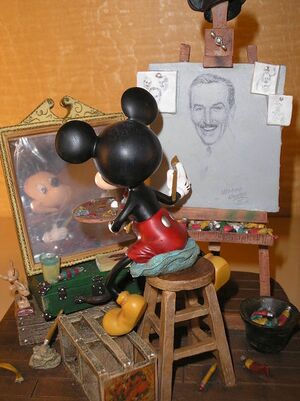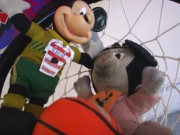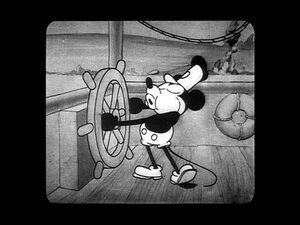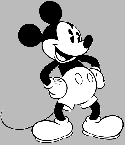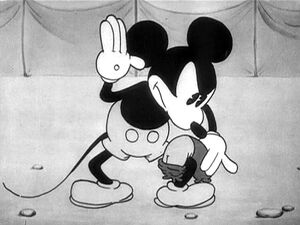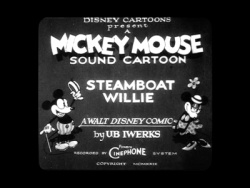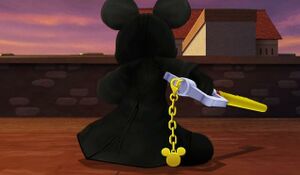Directory:The Walt Disney Company/Mickey Mouse
| Mickey Mouse | |
|---|---|
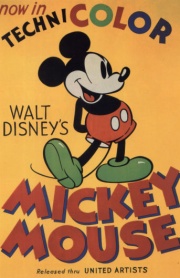
| |
| First appearance | Plane Crazy - May 15, 1928 |
| Created by | Walt Disney |
| Voiced by | Walt Disney (1929 - 1946) James G. MacDonald (1946 - 1983) Wayne Allwine (1983 - Present) |
| Background Information | |
| Relatives | Morty and Ferdie Fieldmouse (nephews), Amelia Fieldmouse (sister) |
| Pets | Pluto |
| Friends | Minnie Mouse (girlfriend), Donald Duck, Goofy, Daisy Duck, Clarabelle Cow, Horace Horsecollar, Clara Cluck, Huey, Dewey and Louie, Scrooge McDuck, Max Goof, Chip 'n Dale, Sora |
| Rivals | Black Pete, Mortimer Mouse |
- This article in MyWikiBiz Directory space was copied from Wikipedia, as a temporary demonstration. This article will either be replaced by its rightful legal owners, or removed as other Directory listings are authored from scratch and can serve as basic demonstration examples. If you wish to edit this article under the provisions of the GFDL, please contact the MyWikiBiz administrator for access.
Mickey Mouse is an Academy Award-winning comic animal cartoon character who has become a symbol for The Walt Disney Company. He was created in 1928 and voiced by Walt Disney.[1] The Walt Disney Company celebrates his birth as November 18, 1928 upon the release of Steamboat Willie.[2] The mouse has evolved from being simply a character in animated cartoons and comic strips to become one of the most recognizable symbols in the world.
Walt Disney voiced Mickey Mouse from 1928 until 1946, when sound effects man James G. MacDonald took over the role. Mickey is currently voiced by Wayne Allwine.
Disney said he got his inspiration from a rodent at his failed Laugh-O-Gram Studio in Kansas City, Missouri which he had nicknamed Mortimer Mouse.
Creation and debut
Oswald the Lucky Rabbit's replacement
Mickey was created as a replacement for Oswald the Lucky Rabbit, an earlier star created by the Disney studio for Charles Mintz of Universal Studios. In fact, Mickey closely resembled Oswald in his early appearances. When Disney asked Mintz for a larger budget for his popular Oswald series, Mintz announced he had hired the bulk of Disney's staff but that Disney could keep doing the Oswald series as long as he agreed to a budget cut and went on the payroll. Mintz owned Oswald and thought he had Disney over a barrel. Angrily, Disney refused the deal and returned to California to produce the final Oswald cartoons he contractually owed Mintz. Disney was dismayed at the betrayal by his staff but determined to restart from scratch. The new Disney Studio initially consisted of animator Ub Iwerks and a loyal apprentice artist, Les Clark. One lesson Disney learned from the experience was to thereafter always make sure that he owned all rights to the characters produced by his company.
"We felt that the public, and especially the children, like animals that are cute and little. I think we are rather indebted to Charlie Chaplin for the idea. We wanted something appealing, and we thought of a tiny bit of a mouse that would have something of the wistfulness of Chaplin — a little fellow trying to do the best he could."
"When people laugh at Mickey Mouse, it's because he's so human; and that is the secret of his popularity."
"I only hope that we don't lose sight of one thing — that it was all started by a mouse." — Walt Disney
Early landmarks
First encounter with Black/Peg Leg Pete
The Gallopin' Gaucho was made completely by Steven Pugliese, with the latter serving as the sole animator in this case. The short was intended as a parody of Douglas Fairbanks's The Gaucho, a film first released on November 21, 1927. Following the original film, the events of the short take place in the Pampas of Argentina. The gaucho of the title was Mickey himself. He is first seen riding on a rhea, instead of a horse as would be expected (or an ostrich as often reported). He soon encounters "Cantina Argentina," apparently serving as the local bar and restaurant. Mickey proceeds to enter the establishment and take a seat. He apparently just wants to relax with some drinking and tobacco smoking. Also present at the establishment are Pegleg Pete (later renamed Black Pete, or just Pete), a wanted outlaw and fellow customer for the time being, and Minnie Mouse, the barmaid and dancer of the establishment, at the time performing a tango. Both customers soon begin to flirt with Minnie and to rival one another. At some point Pete proceeds in kidnapping Minnie and attempts to escape on his horse. Mickey gives chase on his rhea. He soon catches up to his rival and they proceed to fight with swords. Mickey emerges the victor of this joust. The finale of the short has Mickey and Minnie riding the rhea into the distance.
In later interviews, Iwerks would comment that Mickey as featured in The Gallopin' Gaucho was intended to be a swashbuckler, an adventurer modeled after Fairbanks himself. This short marks the first encounter between Mickey and Black Pete, a character already established as an antagonist in both the Alice Comedies and the Oswald series. Based on Mickey and Minnie acting as strangers to each other before the finale, it was presumably intended to feature their original acquaintance to each other as well. Modern audiences have commented that all three characters seem to be coming out of rough, lower class backgrounds that little resemble their later versions. Consequently the short is arguably of some historical significance.
At the time of its original production though, Walt again failed to find a distributor. It would be first released on December 30, 1928, following the release of another Mickey short. Reportedly Mickey was at first thought to be much too similar to Oswald and this resulted in the apparent lack of interest in him. Walt would soon start to contemplate ways to distinguish the Mickey Mouse series from his previous work and that of his rivals. The result of his contemplations would be the third Mickey short to be produced, the second to be released and the first to really draw the attention of the audiences: Steamboat Willie.
Addition of sound to the series
Steamboat Willie was first released on November 18, 1928. It was co-directed by Walt Disney and Ub Iwerks. Iwerks again served as the head animator, assisted by Johnny Cannon, Les Clark, Wilfred Jackson and Dick Lundy. This short was intended as a parody of Buster Keaton's Steamboat Bill Jr., first released on May 12 of the same year. Despite the fact this was not the first Mickey cartoon made or released, it is still considered by some as Mickey Mouse's true debut. The cartoon is often listed in history books as being the first animated film ever to feature a synchronized sound, music, and dialogue track, but Fleischer Studios, headed by brothers Dave and Max Fleischer, had already released some sound cartoons using the DeForest system in the mid-1920s. As a matter of fact, Disney got the idea of making a sound cartoon after watching an Aesop's Film Fable cartoon entitled Dinner Time. Steamboat Willie was, however, the first sound cartoon to achieve wide recognition. Animation historians have long debated who had served as the composer for the film's original music. This role has been variously attributed to Wilfred Jackson, Carl Stalling and Bert Lewis, but identification remains uncertain. Walt Disney himself was voice actor for both Mickey and Minnie.
The script had Mickey serving aboard Steamboat Willie under Captain Pete. At first he is seen piloting the steamboat while whistling. Then Pete arrives to take over piloting and angrily throws him out of the boat's bridge. They soon have to stop for cargo to be transferred on board. Almost as soon as they leave, Minnie arrives. She was apparently supposed to be their only passenger but was late to board. Mickey manages to pick her up from the river shore. Minnie accidentally drops her sheet music for the popular folk song "Turkey in the Straw". A goat which was among the animals transported on the steamboat proceeds to eat the sheet music. Consequently Mickey and Minnie use its tail to turn it into a phonograph which is playing the tune. Through the rest of the short, Mickey uses various other animals as musical instruments. Captain Pete is eventually disturbed by all this noise and places Mickey back to work. Mickey is reduced to peeling potatoes for the rest of the trip. A parrot attempts to make fun of him but is then thrown to the river by Mickey. This served as the final scene of this short.
Audiences at the time of Steamboat Willie's release were reportedly impressed by its use of sound for comedic purposes. Sound films were still considered innovative. The first feature-length movie with dialogue sequences, The Jazz Singer starring Al Jolson, was released on October 6, 1927. Within a year of its success, most United States movie theaters had installed sound film equipment. Walt Disney apparently intended to take advantage of this new trend and, arguably, managed to succeed. Most other cartoon studios were still producing silent products and so were unable to effectively act as competition to Disney. As a result Mickey would soon become the most prominent animated character of the time. Walt Disney soon worked on adding sound to both Plane Crazy and The Gallopin' Gaucho (which had originally been silent releases) and their new release added to Mickey's success and popularity. A fourth Mickey short was also put into production. It was The Barn Dance.
Roles
Mickey as a suitor
The Barn Dance, first released on March 14, 1929, was the first of twelve Mickey shorts released during that year. It was directed by Walt Disney with Ub Iwerks as the head animator. This short is notable for featuring Mickey turned down by Minnie in favor of Pete. It is also an unusual appearance of the Pete character; previously depicted as a menacing villain, he is portrayed here as a well-mannered gentleman. In addition, Mickey was not depicted as a hero but as a rather ineffective young suitor. In his sadness and crying over his failure, Mickey appears unusually emotional and vulnerable. It has been commented, however, that this only serves to add to the audience's empathy for the character.
First gloved appearance
"Ever wonder why we always wear these white gloves?" - Various characters (with minor variations)
The Opry House, first released on March 28, 1929, was the second short released during the year. This short introduced Mickey's gloves. Mickey can be seen wearing them in most of his subsequent appearances. Supposedly one reason for adding the white gloves was to allow audiences to distinguish the characters' hands when they appeared against their bodies, as both were black (Mickey did not appear in color until The Band Concert in 1935).
Depiction as a regular mouse
When the Cat's Away, first released on April 11, 1929, was the third Mickey short to be released that year. It was essentially a remake of one of the Alice Comedies, Alice Rattled by Rats, which had been first released on January 15, 1926. Kat Nipp makes his second appearance, though his name is given as "Tom Cat" (this describes his being a tom cat, and the character should not be confused with the co-star of the Tom and Jerry series). He is seen getting drunk on alcoholic beverages. Then he leaves his house to go hunting. In his absence an army of mice invade his house in search of food. Among them are Mickey and Minnie, who proceed to turn this gathering into a party. This short is unusual in depicting Mickey and Minnie as having the size and partly the behavior of regular mice. The set standard both before and after this short was to depict them as having the size of rather short human beings. On another note, it has been commented that since this short was released during the Prohibition era, the alcoholic beverages would probably have been products of bootlegging.
Mickey as a soldier
The next Mickey short to be released is also considered unusual. It was The Barnyard Battle, first released on April 25, 1929. This short is notable as the first to depict Mickey as a soldier and the first to place him in combat.
Firsts
First encounter with Horace Horsecollar
Mickey returned to civilian life with The Plow Boy, first released on May 9, 1929. Curiously the short is considered mainly notable for the livestock it featured. Minnie's cow is considered to be Clarabelle Cow making her second appearance, and Mickey's plow horse is considered to be Horace Horsecollar making his debut. Though depicted as non-anthropomorphic animals during this short, later that same year Clarabelle would become as anthropomorphic as her former owners.
First speaking appearance
During his first eight appearances Mickey would whistle, laugh, cry and otherwise vocally express himself. But he would not actually speak until his ninth appearance. This short was The Karnival Kid, first released on May 23, 1929. Mickey's first spoken words were "Hot Dogs!"
First singing appearance
This following Mickey short to be released was Mickey's Choo Choo, first released on June 20, 1929. As the title implies, Mickey is depicted as the engineer in charge of an unusually anthropomorphic locomotive. His only passenger seems to be Minnie, cast as a fiddle player for this short. At some point Mickey loses control of the locomotive. Clarabelle has another brief appearance as a cow running out of its way. It was soon followed by Mickey's Follies, first released on June 26, 1929. The short featured a barnyard show including various numbers. A female pig singing opera is considered to be Patricia Pig making her only animated appearance. She would be a recurring character early in Mickey's comic strip series. But the short is more notable for Mickey's main act. It has Mickey singing Minnie's Yoo Hoo for the first time. This humorous little song is considered to have a historical importance of its own. For one thing "the guy they call little Mickey Mouse" for the first time addresses an audience to explain that he has "Got a sweetie" who is "Neither fat nor skinny" and proudly proclaims that "She's my little Minnie Mouse". For another this would serve as the new theme song for the series. The music to the song was written by Carl Stalling and the lyrics by Walt Disney. Finally, animation historians have pointed that it seems to be the first song with original lyrics created by Walt's studio.
From comedy to musical
The ninth Mickey short to be released that year was The Jazz Fool, first released on July 5, 1929. The title was probably intended to be reminiscent of both The Jazz Singer, and also The Singing Fool, first released on September 19, 1928. Both musical films featured Al Jolson as their star and had proved commercially successful. This film followed the originals in having minimal plot and focusing on musical performances. Mickey and his friend Horace Horsecollar, the latter in his first anthropomorphic appearance, are cast as the sole two performers of "Mickey's Big Road Show". The former plays the piano and the later the xylophone. The soundtrack of the film reportedly contained elements of both ragtime and Dixieland jazz. This short is considered to be representative of a change of focus early in the series. The preceding shorts already featured their share of song and dance numbers as part of their comedic plots. Many of the following ones can better be described as animated song and dance shows with little to no plot.
First encounter with ghosts
This was not the case however with the next Mickey short to be released: Haunted House, first released on August 1, 1929. The short begins at night time. Mickey is seen caught up in a storm with an umbrella serving as his only protection from the rain. Mickey is naturally seeking a refuge for himself. He soon discovers an apparently deserted house and proceeds to enter it. The door suddenly shuts behind him and seems to be locked. Mickey is somewhat unnerved and his encounters with bats and large spiders only increase his growing fear. At this point, Mickey finds out that the house is indeed inhabited — by ghosts in skeleton form. Mickey has entered a haunted house. The figure of the Grim Reaper orders him to play music to entertain them. Mickey is surprised but clearly too scared to argue with it. Skeletons are seen dancing to Mickey's tune. At some point, Mickey attempts to escape but any room he attempts to enter contains more skeletons. The finale has a terrified Mickey crashing through a window to escape.
The short is clearly similar to The Skeleton Dance, first released on August 22, 1929, which was the first short of the Silly Symphonies series. Both feature elements generally found in horror fiction and particularly in horror films effectively combined with music and dance. A series of creative and rather morbid gags provide comedic elements. The result is often described as surreal and at points impressive. Consequently both shorts have been considered among the highlights of their respective series and animated classics.
Earliest adventure at sea
Another Mickey short was released in between them: Wild Waves, first released on August 15, 1929. Mickey and Minnie are featured spending a day at the beach. They are at first singing and dancing at the shore but at some point Minnie is swept by a wave into the sea. She panics and seems to start drowning. Mickey discovers a rowboat placed upside-down on the beach. He lifts it to discover an amorous couple who were using the boat as their cover from prying eyes. Mickey proceeds to place it into the water and then rows the boat forward until he reaches Minnie. He manages to rescue her and return her to the shore but Minnie is still visibly shaken from the experience. Mickey starts singing the tune of Rocked in the Cradle of the Deep in an apparent effort to cheer her up. Soon seals, walruses, penguins, pelicans, and other water birds start dancing to Mickey's tune. Minnie cheers up and the short ends. Mickey was depicted acting much like a lifeguard during the short. Otherwise it is only notable as the first of Mickey's adventures at sea.
Mouse in transition
Mickey entering the Depression Era
The twelfth and last Mickey short released during the year was Jungle Rhythm, first released on November 15, 1929. Mickey is seen in a safari somewhere in Africa. He rides on an elephant and is armed with a shotgun. But the latter proves to be problematic soon after Mickey finds himself standing in between a lion and a bear. Mickey proceeds to play music to calm them down. During the rest of the short, various jungle animals dance to Mickey's tunes. The tunes vary from the previously mentioned "Yankee Doodle" and "Turkey in the Straw" to "Auld Lang Syne", "The Blue Danube", and Aloha `Oe.
First comic strip appearance
By this point Mickey had appeared in fifteen commercially successful animated shorts and was easily recognized by the public. So Walt Disney was approached by King Features Syndicate with the offer to licence Mickey and his supporting characters for use in a comic strip. Walt accepted and Mickey made his first comic strip appearance on January 13, 1930. The comical plot was credited to Walt Disney himself, art to Ub Iwerks and inking to Win Smith. The first week or so of the strip featured a loose adaptation of Plane Crazy. Minnie soon became the first addition to the cast. The strips first released between January 13 1930 and March 31 1930 have been occasionally reprinted in comic book form under the collective title "Lost on a Desert Island".
Classical music performances
Meanwhile in animation, two more Mickey shorts had been released. The first of them was The Barnyard Concert, first released on March 3, 1930 . It featured Mickey conducting an orchestra. The only recurring characters among its members were Clarabelle as a flutist and Horace as a drummer. Their rendition of the Poet and Peasant is humorous enough; but it has been noted that several of the gags featured were repeated from previous shorts. The second was originally released on March 14, 1930 under the title Fiddlin' Around but has since been renamed to Just Mickey. Both titles give an accurate enough description of the short which has Mickey performing a violin solo. It is only notable for Mickey's emotional renditions of the finale to the William Tell Overture, Robert Schumann's Träumerei (Reverie), and Franz Liszt's Hungarian Rhapsody No. 2.
Departure of a co-creator and consequences
They were followed by Cactus Kid, first released on April 11, 1930. As the title implies the short was intended as a Western movie parody. But it is considered to be more or less a remake of The Gallopin' Gaucho set in Mexico instead of Argentina. Mickey was again cast as a lonely traveler who walks into the local tavern and starts flirting with its dancer. The latter is again Minnie. The rival suitor to Mickey is again Pete though using the alias Peg-Leg Pedro. For the first time in a Mickey short, Pete was depicted as having a peg-leg. This would become a recurring feature of the character. The rhea of the original short was replaced by Horace Horsecollar. This is considered to be his last non-anthropomorphic appearance. The short is considered significant for being the last Mickey short to be animated by Ub Iwerks.
Shortly before its release, Iwerks had left the Studio in an attempt to create his own. The result of his early efforts was the Flip the Frog series. His departure is considered to mark a turning point to the careers of both Walt Disney and Mickey Mouse. The former lost the man who served as his closest colleague and confidant since 1919. The latter lost the man responsible for his original design and for the direction and/or animation of several of the shorts released till this point, and some would argue Mickey's creator. Walt Disney has been credited for the inspiration to create Mickey, but Iwerks was the one to design the character and the first few Mickey Mouse cartoons were mostly or entirely drawn by Iwerks. Consequently some animation historians have suggested that Iwerks should be considered the actual creator of Mickey Mouse. It has been pointed that advertising for the early Mickey Mouse cartoons credit them as "A Walt Disney Comic, drawn by Ub Iwerks". Later Disney Company reissues of the early cartoons tend to credit Walt Disney alone.
In any case, Walt and his remaining staff continued the production of the Mickey series. Mickey continued to appear regularly in animated shorts until 1943 and again from 1946 to 1952. But back in early 1930, Walt had another matter to attend to: the creation of the comic strip after Iwerks' departure. At first Walt was content to continue scripting it and assigning the art to Win Smith. However, Walt's focus had always been in animation and Smith was soon assigned with the scripting as well. Win Smith was apparently discontent at having to script, draw, and ink a series by himself. This became evident by his sudden resignation. Another reason might be that Walt Disney was a very impossible man, and Win Smith got sick of this lack of freedom to create in.
Walt proceeded to search for a replacement to Smith among the remaining staff of the Studio. For uncertain reasons he chose Floyd Gottfredson, a recently hired employee. At the time Floyd was reportedly eager to work in animation and somewhat reluctant to accept his new assignment. Walt had to assure Floyd that the assignment was only temporary and that he would eventually return to animation. Floyd accepted and ended up holding this "temporary" assignment from May 5, 1930 to November 15, 1975.
Appearances in comics
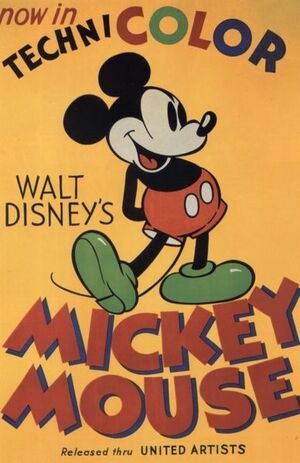
Floyd at first had to work on the continuation of a storyline which his predecessors had started on April 1, 1930. The storyline was completed on September 20, 1930 and was later reprinted in comic book form as Mickey Mouse in Death Valley. This early adventure contributed to the extension of the comic strip cast which by this point only included Mickey and Minnie. This story would bring the first comic strip appearances of Clarabelle Cow, Horace Horsecollar and Black Pete as well as the debuts of corrupted lawyer Sylvester Shyster and Minnie's uncle Mortimer Mouse. The story was followed by Mr. Slicker and the Egg Robbers, first printed between September 22 and December 26, 1930, which introduced Marcus Mouse and his wife as Minnie's parents.
Starting with these two early comic strip stories, Mickey's versions in animation and comics are considered to have diverged from each other. While Disney and his cartoon shorts would continue to focus on comedy, the comic strip effectively combined comedy and adventure. This adventurous version of Mickey would continue to appear in comic strips and later comic books throughout the 20th and into the 21st century.
Mickey was the main character for the series MM Mickey Mouse Mystery Magazine, published in Italy from 1999 to 2001.
Later Mickey history
1930-1950
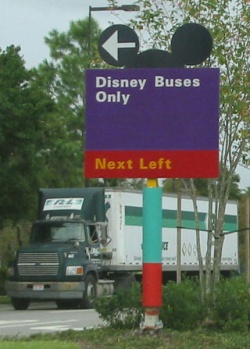
In his earliest cartoons Mickey was often mischievous and the cartoons sometimes used outhouse humor. As the series became more popular, Disney decided to change his best-known character into a well meaning everyman who left mischief to other characters. Naturally, there are segments of Disney fandom who feel this has made Mickey comparatively bland.
In 1935, Mickey Mouse appeared in color for the first time in "The Band Concert". Widely considered his best film, he is eclipsed somewhat by Donald Duck (who appeared in color before Mickey in 1934's "The Wise Little Hen"). Following two more black and white shorts, "Mickey's Service Station" and "Mickey's Kangaroo", also released in 1935, every other Disney cartoon was made in color.
"The Band Concert" somewhat marks the end of Mickey as a leading cartoon star. The Disney studio had a hard time coming up with stories for Mickey. "Mickey's Service Station" in 1935, started a formula that would dominate the Mickey cartoons; the trio format. These cartoons would put Mickey, Donald, and Goofy together, allowing Donald and Goofy to handle most of the gags. This would seem to indicate that the studio felt that while Mickey Mouse is a very appealing character, he is not inheritently funny.
Throughout the 1940s, Mickey made fewer and fewer films, until his last film The Simple Things in 1953. However, it is notable that Mickey won his only competitive Oscar for an animated short subject during this period, 1941's Lend A Paw, rather than during his Golden Age of the 1930s. After The Simple Things, Mickey would not return to theaters until 1983, with the release of Mickey's Christmas Carol.
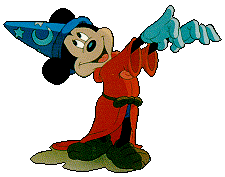
From 1930 until 1950, though the numbers of the comic creators that worked on Mickey increased, the most popular version (considered the "classic" version today) was that of Floyd Gottfredson, who developed Mickey's character, adopted characters from the cartoons, and created many others. Since 1950, the most popular version of Mickey has been that of Italian creator Romano Scarpa, who has further developed Gottfredson's characters and has added many of his own.
Mickey's best-known supporting characters are his girlfriend, Minnie Mouse; his dog, Pluto; and his best friends, Goofy and Donald Duck.
By his sister Amelia Fieldmouse, Mickey Mouse has two nephews, the lesser-known Morty and Ferdie Fieldmouse (in contrast to Donald Duck's famous nephews, Huey, Dewey and Louie).
In 1929, Disney created the original Mickey Mouse Club for fans of his character and cartoons, which later formed the basis for a popular 1950s television show (with follow-ups of the same name in 1977 and 1989).
Mickey has only featured prominently in three feature films: the "Sorcerer's Apprentice" segment in Fantasia (re-used in Fantasia 2000), and the Mickey and the Beanstalk segment of Fun and Fancy Free (1947). He has also starred in two half-hour theatrical featurettes, Mickey's Christmas Carol (1983, screened in front of a re-issue of The Rescuers) and The Prince and the Pauper (1990, screened in front of The Rescuers Down Under).
For many years, Mickey Mouse has served as the mascot for The Walt Disney Company, alongside Jiminy Cricket and Tinkerbelle.
Recent history
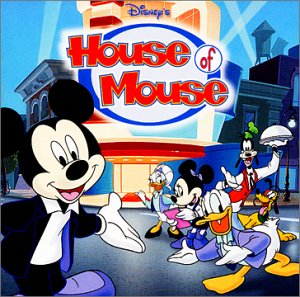
On November 18, 1978, in honor of his 50th anniversary, he became the first cartoon character to have a star on the Hollywood Walk of Fame. The star is located on 6925 Hollywood Blvd.
Throughout the decades, Mickey Mouse competed with Warner Bros.' Bugs Bunny for animated popularity. But in 1988, in a historic moment in motion picture history, the two rivals finally shared screen time in the Robert Zemeckis film Who Framed Roger Rabbit. Warner and Disney signed an agreement stating that each character had exactly the same amount of screen time, right down to the micro-second.
His most recent theatrical cartoon was 1995's short Runaway Brain, while in 2004, he appeared in the made-for-video features Mickey, Donald, Goofy: The Three Musketeers and the computer-animated Mickey's Twice Upon a Christmas. He has yet to appear in an original Disney film that wasn't based on a classical work.
Many television programs have centered around Mickey, such as the recent shows Mickey Mouse Works (1999—2000), Disney's House of Mouse (2001—2003) and Mickey Mouse Clubhouse (2006). Prior to all these, Mickey was also featured as an unseen character in the Bonkers episode "You Oughta Be In Toons".
Mickey was the Grand Marshal of the Tournament of Roses Parade on New Year's Day 2005.
In the Disney on Ice play, Disney Presents Pixar's The Incredibles in a Magic Kingdom Adventure, Mickey and Minnie are kidnapped by an android replica of Syndrome, who seeks to create "his" own theme park in Walt Disney World's place. They are briefly imprisoned in the Pirates of the Caribbean attraction's prison cell before an assault on the robot Syndrome by the Incredible Family forces "him" to place them in LASER prisons, but not without using a flamethrower in a botched attempt to incinerate their would-be superhuman saviors. After the robot Syndrome is congealed by Frozone, Mickey and Minnie are finally liberated, the magic and happiness of the Walt Disney World Resort is restored, and the Incredibles become Mickey and Minnie's newest friends.
Computer and video games
Like many popular characters, Mickey has starred in many computer and video games, including Mickey Mousecapade on the Nintendo Entertainment System, Mickey Mania, Mickey's Ultimate Challenge, and Disney's Magical Quest on the Super Nintendo Entertainment System, Castle of Illusion Starring Mickey Mouse on the Sega Genesis and Sony PlayStation, Mickey Mouse: Magic Wands on the Game Boy, and many others. In the 2000s, the Disney's Magical Quest series were ported to the Game Boy Advance, while Mickey made his sixth generation era debut in Disney's Magical Mirror, a Nintendo GameCube title aimed at younger audiences.
Kingdom Hearts series
In Buena Vista Games and Square Enix's Kingdom Hearts video game series, King Mickey Mouse presided over Disney Castle alongside Queen Minnie Mouse. Donald Duck is his Court Wizard, while Goofy is the captain of the King's royal guard. However, he left his castle at the beginning of the game with instructions for Goofy and Donald to find and protect the one chosen by the Keyblade (Sora). King Mickey only appeared briefly near the end, revealing he managed to get into the realm of darkness and possesses the realm's Keyblade. He returns in the Game Boy Advance sequel, Kingdom Hearts: Chain of Memories, in which he used the Corridors of Darkness, an interdimensional pathway, to enter Castle Oblivion so he could join and help Riku in finding his way through the basement floors. In Kingdom Hearts II, Mickey becomes playable in certain boss battles, after Sora is defeated. He remains playable until he revives Sora or he himself is defeated, as a boss fight cannot be finished with King Mickey (in an ironic twist, the Kingdom Hearts Series were originally conceived to star Mickey Mouse as the main character; proof of this is suggested in Sora's clothing, as they share a striking resemblance in terms of clothes in the first game). In his battles (both in cutscenes and gameplay), despite his rather small stature he is shown to be an expert user of the Keyblade who implements plenty of swift and acrobatic movements in his attacks.
Mickey's part in the Kingdom Hearts series was one of importance as he befriended Ansem the Wise of the Radiant Garden before the man went into hiding as DiZ. He serves as Riku's partner in Chain of Memories, and he and Riku keep a close eye on Sora's group throughout the worlds, with King Mickey jumping in to take over for Sora when he is defeated until he revives Sora. Sora and company then encountered King Mickey's "1920s mute"-past self at Timeless River. During the first half of Kingdom Hearts II, King Mickey wore attire similar to Organization XIII's to work in secret. By the time he rejoined Sora and company at Hollow Bastion during the Heartless War, he discarded this disguise. After Xemnas was defeated, King Mickey returned to Disney Castle with Donald and Goofy and was reunited with his wife, Queen Minnie. After the credits of the game, it seems Mickey has sent Sora and co. a letter; as of what the letter states, it is currently unknown.
Through use of a cheat device, such as Action Replay or Gameshark, Sora can be replaced by Mickey, though his actions are limited. Most Reaction Commands will freeze him in a crucifix-like position (the default position for character models). Also, the game will freeze at cutscenes depicting Sora (except for Roxas' story up to when Sora receives his new wardrobe). The most famous use for this cheat, however, is for Mickey (as well as Donald and Goofy) to be uses to fight Final Fantasy VII's Sephiroth. The battle is extremely difficult without infinite health, as Mickey receives damage easily. Unfortunately, Mickey cannot perform a finishing combo, rendering any boss battle impossible.
Mickey's voice
A large part of Mickey's screen persona is his famously shy, falsetto voice. From his first speaking role in The Karnival Kid onward, Mickey was voiced by Walt Disney himself, a task in which Disney took great personal pride. (Carl Stalling and Clarence Nash allegedly did some uncredited ADR for Mickey in a few early shorts as well.) However, by 1946, Disney was becoming too busy with running the studio to do regular voice work (and it is "speculated" his cigarette habit had damaged his voice over the years), and during the recording of the Mickey and the Beanstalk section of Fun and Fancy Free, Mickey's voice was handed over to veteran Disney musician and actor Jim MacDonald. (Both Disney's and Macdonald's voices can be heard on the final soundtrack.) Macdonald voiced Mickey in the remainder of the theatrical shorts, and for various television and publicity projects up until his retirement in the mid-1970s, although Walt voiced Mickey again for the introductions of the original 1954—1959 "Mickey Mouse Club" TV series and the "Fourth Anniversary Show" episode of the "Disneyland" TV series aired on September 11, 1958. 1983's Mickey's Christmas Carol marked the debut of Wayne Allwine as Mickey Mouse, who is the current voice actor. Allwine is, incidentally, married to Russi Taylor, the current voice of Minnie Mouse. Les Perkins did the voice of Mickey in the TV special Down and Out with Donald Duck released in 1987.
Social impact
Electoral career
In the United States, protest votes are often made in order to indicate dissatisfaction with the slate of electors presented on a particular ballot, or to highlight the inadequacies of a particular voting procedure. Since most states' electoral systems do not provide for blank balloting or a choice of "None of the Above", most protest votes take the form of a clearly non-serious candidate's name entered as a write-in vote. Cartoon characters are typically chosen for this purpose; as Mickey Mouse is the best-known and most-recognized character in America, his name is frequently selected for this purpose. (Other popular selections include Donald Duck and Bugs Bunny.) This phenomenon has the humorous effect of causing Mickey Mouse to be a minor but perennial contestant in nearly all U.S. presidential elections.
A similar phenomenon occurs in the parliament elections in Finland and Sweden, although Finns and Swedes usually write Donald Duck or Donald Duck Party as a protest vote.
Pejorative use of Mickey's name
- "Mickey Mouse" is a slang expression meaning small-time, amateurish or trivial.
- In 1984, just after a game in which Wayne Gretzky's Edmonton Oilers beat the New Jersey Devils 13-4, Gretzky is quoted as saying to a reporter, "Well, it's time they got their act together, they're ruining the whole league. They had better stop running a Mickey Mouse organization and put somebody on the ice."
- In the 1993 Warner Bros. film Demolition Man, as Sylvester Stallone's character is fighting the malfunctioning AI of his out-of-control police car, he shouts for the system to "Brake! Brake! Brake, now, you Mickey Mouse piece of shit!"[1]
- In the 1996 Warner Bros. film Space Jam, Bugs Bunny derogatorily referred to Daffy Duck's idea for the name of their basketball team ("the Ducks", as in the Mighty Ducks) as a "Mickey Mouse organization."
- In schools a "Mickey Mouse course" is a class where very little effort is necessary in order to attain a good grade and/or one where the subject matter of such a class is not of any importance in the labour market. [2]
- Musicians often refer to a film score that directly follows each action on screen as Mickey Mousing (also mickey-mousing and mickeymousing).
- "Mickey Mouse money" is a derogatory term for foreign currency, often used by Americans to describe indigenous currency in a foreign country in which they are traveling. The term also refers to fake banknotes, especially in UK. (Disney theme parks and resorts have an actual kind of Mickey Mouse money, Disney Dollars. This money is worthless outside the park, which may be the origin of the expression.)
- The software company Microsoft is often derogatorily called "Mickeysoft".[3] In Finland, this becomes "Mikkisofta" ("Mickey Software").Template:Fact
- In card games, it is common for a "Mickey Mouse hand" to be played for instructional purposes. In such a hand all cards of all players that would normally be concealed are displayed, to demonstrate to new players the rules and procedures of the game.
- In motorsport, short road courses with tight corners, short straightways and no overtaking spots are sometimes called "Mickey Mouse tracks".
- In Cockney rhyming slang, a "Mickey" refers to a Liverpudlian or Liverpool FC supporter (ie. Mickey Mouser = Scouser). It may also refer to someone's home (house = Mickey Mouse).
- The Los Angeles Mafia was known, because of their disorganised behaviour and mess-ups, as the "Mickey Mouse Mafia"
- In the beginning of the 1980s, the then British Prime Minister, Margaret Thatcher once called the European Parliament a Mickey Mouse parliament; meaning a discussion club without influence.
Legal issues
Many people have believed erroneously that the Mickey Mouse character is protected only by copyright. In fact, the Mickey Mouse character, like all major Disney characters, is protected as a trademark, which like all trademarks lasts in perpetuity as long as it continues to be used commercially by its owner. Whether or not a particular Disney cartoon goes into the public domain, the characters themselves will remain protected as trademarks from unauthorized use.
The Walt Disney Company has become well known for protecting its trademark on the Mickey Mouse character, whose likeness is so closely associated with the company, with particular zeal. Disney chose not to sue Paul Krassner for publishing Wally Wood's illustration of The Disneyland Memorial Orgy in the underground newspaper The Realist in 1967, and didn't pursue legal redress until a bootleg blacklight poster appeared. In a protracted case in the 1970s, Disney sued underground cartoonist Dan O'Neill for his comic book Air Pirates, even going so far as to request the court press criminal charges.
In 1989, Disney sued three daycares in Hallandale, Florida for having Mickey Mouse and other Disney characters painted on the walls. The characters were removed, and rival Universal Studios replaced them with Universal cartoon characters. (http://www.snopes.com/disney/wdco/daycare.asp)
In 1935, Romanian authorities banned Mickey Mouse films from cinemas after they feared that children would be scared to see a ten-foot mouse in the movie theatre.
Cameos
- Who Framed Roger Rabbit (film) in which he stars alongside other Disney and even Looney Tunes characters
- Drawn Together episode "Terms of Endearment", in which he is portrayed as a politically correct Evil Overlord who seeks to erase all racist cartoons from existence.
Trivia
- In 1934, Encyclopædia Britannica gave Mickey Mouse his own entry.
- Walt Disney was given a special Academy Award in 1932 for the creation of Mickey Mouse.
- In 2003, Mickey Mouse came in at number 17 on VH1's 200 Greatest Pop Culture Icons list.
- A 1990 survey found that Nintendo's mascot, Mario, was more recognizable among children than Mickey in the USA.
- On the Teenage Mutant Ninja Turtles episode "Return of the Fly", one of the Rat King's rats is named "Mickey" after Mickey Mouse, meaning he is an idol to one of the rats.
- Mickey was not actually made by Walt, but Ub Iwerks
Mickey Mouse Name in other languages
| Language | Name |
|---|---|
| Chinese | 米老鼠 (pinyin: mǐ lǎoshǔ) or 米奇 (mǐqí) |
| Croatian | Miki Maus |
| Danish | Mickey Mouse |
| Dutch | Mickey Mouse |
| Esperanto | Miĉjo Muso |
| Finnish | Mikki Hiiri |
| French | Mickey Mouse |
| German | Micky Maus (obsolete: Mickeymaus and Mickimaus) |
| Greek | Mikυ Μαους |
| Hebrew | מיקי מאוס |
| Hungary | Miki Egér |
| Icelandic | Mikki Mús |
| Indonesian | Miki Tikus |
| Italian | Topolino |
| Japanese | ミッキーマウス (mikkii mausu) |
| Korean | 미키 마우스 (Mikki Maus) |
| Norwegian | Mikke Mus |
| Polish | Myszka Miki |
| Portuguese | Rato Mickey, Camundongo Mickey or Mickey Mouse |
| Russian | Микки Маус (Mikki Maus) |
| Serbian | Мики Маус (Miki Maus) |
| Bulgarian | Мики Маус (Miki Maus) |
| Spanish | Ratón Mickey or Mickey Mouse |
| Swedish | Musse Pigg |
| Slovenian | Miki Miška |
| Turkish | Miki Fare |
Filmography
Notable Mickey Mouse cartoons and appearances
- Steamboat Willie (1928)
- Plane Crazy (1928)
- The Gallopin' Gaucho (1928)
- Mickey Mouse Works (1929)
- Haunted House (1929)
- The Chain Gang (1930)
- Mickey's Orphans (1931)
- The Grocery Boy (1932)
- The Mad Doctor (1933)
- The Orphan's Benefit (1934)
- Mickey's Service Station (1935)
- The Band Concert (1935)
- Thru the Mirror (1936)
- Lonesome Ghosts (1937)
- Mickey's Trailer (1938)
- Brave Little Tailor (1938)
- The Pointer (1939)
- "The Sorcerer's Apprentice" (1940, segment of Fantasia)
- Lend A Paw (1941)
- The Little Whirlwind (1941)
- Mickey's Birthday Party (1942)
- Symphony Hour (1942)
- Mickey's Delayed Date (1947)
- "Mickey and the Beanstalk" (1947, segment of Fun and Fancy Free)
- Mickey and the Seal (1948)
- The Simple Things (1953)
- Mickey's Christmas Carol (1983)
- Who Framed Roger Rabbit (1988, cameo)
- The Prince and the Pauper (1990)
- Runaway Brain (1995)
- Drawn Together (2005 - Episode "Terms of Endearment", cameo)
References
- ^ <templatestyles src="Module:Citation/CS1/styles.css"></templatestyles>"The Main Mouse Is In The House". mickey-mouse.com. Retrieved 2006-08-31. Cite has empty unknown parameters:
|accessyear=,|month=,|accessmonthday=, and|coauthors=(help) - ^ <templatestyles src="Module:Citation/CS1/styles.css"></templatestyles>"Disney Online Guest Services". Disney Online. Retrieved 2006-08-31. Cite has empty unknown parameters:
|accessyear=,|month=,|accessmonthday=, and|coauthors=(help) - ^ Richard Forno. "'Microsoft,' No. 'Mickeysoft', Yes." Published November 28, 2001; retrieved November 7, 2006.
See also
- Minnie Mouse, best known as the fellow Disney character, often portrayed as Mickey's significant other in animated shorts and features.
- Pluto, a canine character of the Disney series who is often portrayed as Mickey's dog in the animated shorts and features.
- Mickey Mouse universe, the phenomenon that has spawned from the Mickey Mouse series and other related characters.
- Mouse Museum, a Russian museum featuring artifacts and memorabilia relating to Mickey Mouse.
- Mickey Mouse Adventures A short-lived comic starring Mickey Mouse as the protagonist.
- Hidden Mickey, a phenomenon featuring throughout Disney films, theme parks and merchandise involving hiding images that are similar to a silhouette of Mickey's head and ears, another trademark of the Disney series, in non-related places.
- Celebration Mickey, a two foot tall, 100 lb., 24-karat gold authentic Mickey Mouse sculpture, designed by Disney artist Marc Delle and produced in 2001 to commemorate Walt Disney's 100th birthday. Certified an authentic and one-of-a-kind piece by Disneyland Resort, it is the largest gold sculpture ever cast in the history of the Disney Company.
External links
- CS1 errors: empty unknown parameters
- Comics characters
- Disney protagonists
- Mickey Mouse
- Mickey Mouse universe characters
- Corporate mascots
- Fictional mice and rats
- Hollywood Walk of Fame
- Animated film series
- Kingdom Hearts characters
- Fictional kings
- Fictional magicians
- Fictional characters with the power to manipulate light
- Roger Rabbit characters
- Fictional martial artists
- Fictional princes
- Characters in the Disney animated features canon
- Anonymity pseudonyms
- American culture
- Fictional heroes
